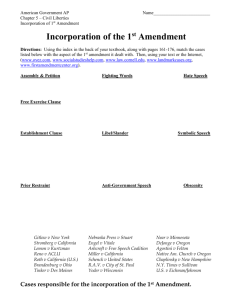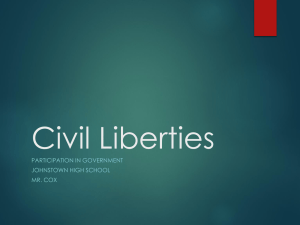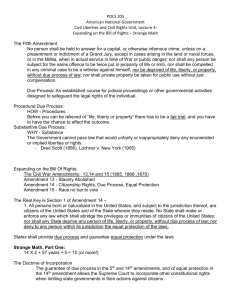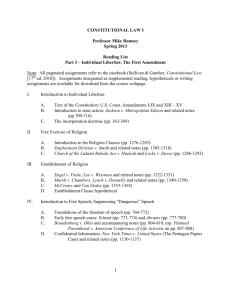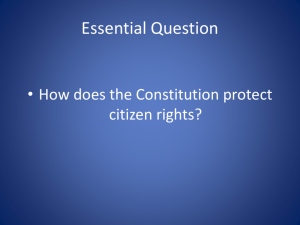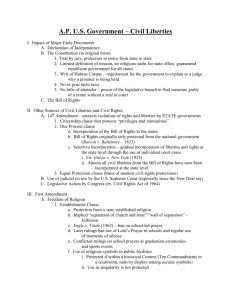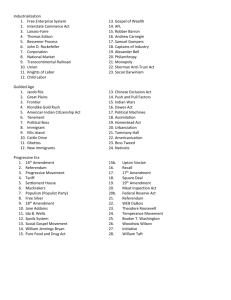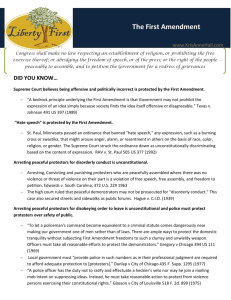mr. lipman`s ap government powerpoint
advertisement
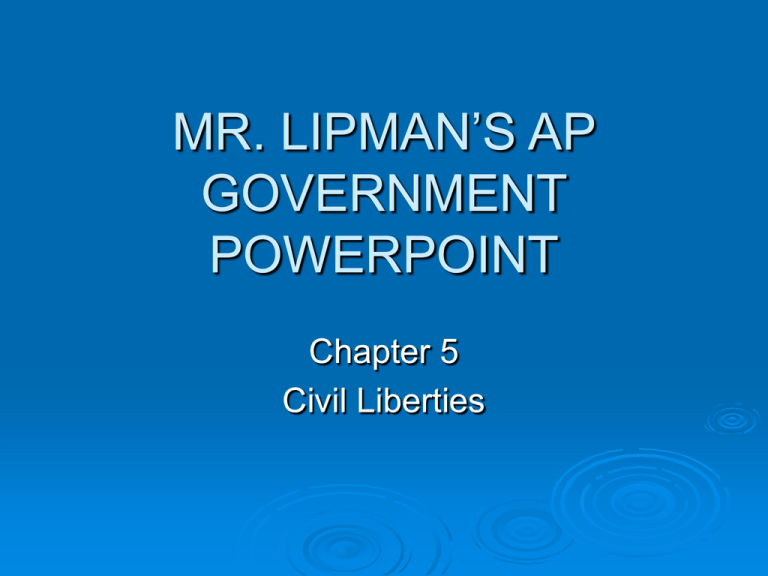
MR. LIPMAN’S AP GOVERNMENT POWERPOINT Chapter 5 Civil Liberties Civil Liberties emanate from the Bill of Rights and are designed to place restrictions on what the Government can do. Civil Rights emanate from the Civil War amendments (13, 14 and 15) and are designed to provide protections for citizens. Doctrine of Selective Incorporation Barron v. Baltimore (1833) Gitlow v. New York (1925) becomes the first case to mention the possibility of it. Near v. Minnesota (1931) becomes the first to use it. Religion and the First Amendment Establishment Clause: intended to prevent government from involving itself in religion Free Exercise Clause: intended to prevent government from interfering with individuals practicing of their religion. State Law and Religion In order to determine if a state law is somehow violating the Constitutional requirements of the first amendment the courts use a test set forth in the case of Lemon v. Kurtzman (1971) and they have also developed three (3) levels of review. Strict Scrutiny (suspect class-race/national origin) Mid Level Scrutiny (gender and alienage) Rational Relationship (all others) THE KURTZMAN TEST A state law will be found to be constitutional if: 1. It has a secular purpose 2. It neither advances or inhibits religion 3. It does not foster excessive government entanglement with religion **But since the 1980s (Reagan era) the court has been more willing to “lower the wall” that separates religion and government as long as the law does not involve school prayer.** FEDERAL EQUAL ACCESS ACT Law Passed in 1984 bars public schools from denying access to the facilities of the school by religious groups if other groups are also granted access. Key: State laws which interfere with religious practices (including “drug use”) must be found to have a compelling state interest. Free Speech and the First Amendment Thoughts have the greatest protection, actions the least and words are somewhat in the middle of the court’s protection. In almost all cases prior restraint has been found to be unconstitutional. Schenck v. United States (1919) Court does uphold restriction on free speech because WWI presented a “Clear and Present Danger”. Problem with this case is determining what is a “danger”. To solve the “danger” problem court comes up with a new test in Brandenburg v. Ohio (1969) and says that government can interfere only if it can show that a person’s actions did or will “create imminent lawless action” Speech and the First Amendment v. U.S.(1971) “The Pentagon Papers case”…No prior restraint of press. NYTimes Tinker v. Des Moines School District (1969) “The symbolic speech case” Burning the flag as a form of political protest is not a crime. Speech that is not Protected Defamation (both libel and slander) NYTimes .v Sullivan (1964)…public figure must demonstrate actual malice to prove case. Obscenity (community standards) “Fighting words” …Chaplinsky v. New Hampshire…No government protection if the words “by their mere utterance inflict injury or tend to incite an immediate breech of the peace. THE OTHER AMENDMENTS – Gun control ( McDonald v. Chicago (2010) the Supreme Court holds that the doctrine of incorporation does apply). 2ND Amendment 4th Amendment- Exclusionary Rule (Weeks v. United States 1914) applied through selective incorporation doctrine to the states in the case of Mapp v. Ohio (1961). THE FOLLOWING HAVE BEEN SELECTIVELY INCORPORORATED TO THE STATES 5th Amendment: Miranda v. Arizona (1966) 5th Amendment: Due Process 6th Amendment: Right to fair trial; right to counsel 8th Amendment: Prohibiting Cruel and Unusual Punishment…Furman v. Georgia (1972) found capital punishment unconstitutional but then Greeg v. Georgia (1976) reinstates it. The Right to Privacy This is a judicially created right found to be implied (“penumbras-unstated liberties found to exist through express rights”) Griswold v. Connecticut (1965)..contraception Roe v. Wade (1973)..abortion Lawrence v. Texas (2003)..homosexuality These cases expanded the right but more recently the right has been reduced in cases like Planned Parenthood v. Casey (1992) as long as an “undue burden” is not imposed.

